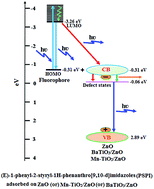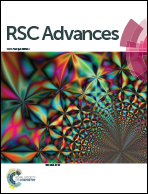Styryl phenanthrimidazole-fluorescence switched on by core/shell BaTiO3/ZnO and Mn-doped TiO2/ZnO nanospheres and switched off by the core nanoparticles
Abstract
Absorption, fluorescence and lifetime spectral studies have been carried out to probe the interaction of fluorophore (E)-1-phenyl-2-styryl-1H-phenanthro[9,10-d]imidazole with sol–gel synthesised BaTiO3/ZnO and Mn-doped TiO2/ZnO core/shell and pristine ZnO nanospheres and BaTiO3 and Mn-doped TiO2 nanoparticles. The emission of fluorophore is switched on by Mn-doped TiO2/ZnO and BaTiO3/ZnO core/shell and pristine ZnO nanospheres, and switched off by Mn-doped TiO2 and BaTiO3 nanoparticles owing to charge injection from the excited singlet state of fluorophore to the conduction band (CB) of the nanosemiconductors. The affinity of the fluorophore to ZnO results in the lowering of HOMO and LUMO energy levels of fluorophore, leading to emission at ∼420 nm. This is due to LUMO → HOMO, LUMO → CB and deep level emission (DLE) of ZnO resulting in the enhancement of fluorescence. The HOMO and LUMO energy levels of the fluorophore are unlikely to be influence by core BaTiO3 and Mn-doped TiO2 nanoparticles. This leads to quenching of fluorescence because of electron transfer from LUMO → CB.


 Please wait while we load your content...
Please wait while we load your content...